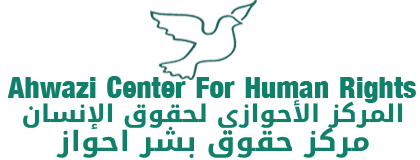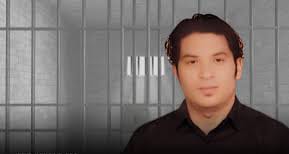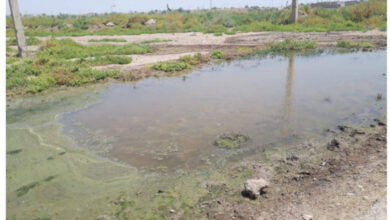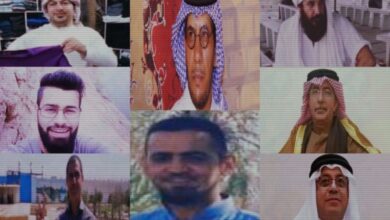The weapon of forced displacement against the indigenous Ahwazi Arabs

Since the Islamic Republic Regime’s rise to power, the mullahs’ regime has enforced ethnocide
policies against Ahwazi Arab and other non-Persian minorities. In fact, the threat of forced displacement, deportation or execution of the Ahwazis, Kurds, Turks, Baluchs and Turkmens has been a persistent threat inside Iran. The lack of reaction by the international community concerning the state of human rights in the Ahwaz region and other non-Persian regions, has given the Iranian regime the right of life and death over entire communities.
Since 1925, both the former Pahlavi monarchy and successive Islamic Republic Regimes have carried a deep historical antipathy toward the Arab nationalities. They have continued a policy of Persianization and ethnic cleansing in Ahwazi regions. Tens of thousands of Ahwazis were displaced mainly in the regions of Mohamerah, Abadan and Shush and Shushtar since 1925, but the rate of displacement has increased since the Islamic Republic took power in 1979. A close link can be established between the rise to power of the Islamic republic regime in 1979 and the forced displacement, deportations and migratory waves of Ahwazi Arabs.
It seems that the Iranian regime’s totalitarian policy has failed to obliterate the identity of non-Persian people. The ongoing mass execution , the massive impoverishment (see UN Special Rapporteur Miloon Kothari’s comments on the Ahwaz human rights situation, 9 August 2005, cultural dispossession and the denial of all fundamental civil, cultural, human, and political rights have failed to destroy the will of non-Persian population. The regime has adopted a systematic and brutal policy encompassing all non-Persian regions, a policy that has systematic demographic and ethnic roots.
For example, the regime has begun to divert Karoon river water from its main course to the arid central Persian regions like the provinces of Yazd and Isfahan. This will potentially would cut off drinking water and cause increases in illness in Ahwaz. The resulting water scarcity will cripple the local agricultural economy and cause widespread desertification, processes that have already begun and are behind the systematic ethnic cleansing and forced migration of Arabs in Ahwaz. On Thursday, 4 September 2014, thousands of the Ahwazi Arab residents gathered by the bank of Karoon River and formed a human chain in the Ahwazi capital in protest against the regime’s unjustifiable policy of diverting the Karoon’s water to the central regions of Iran. The Ahwazi Arab protesters have called on Gary Lewis, the United Nations Commissioner and Chairman of the Human Development Programme in Tehran to take action and intervene to urge the Iranian authorities to stop the Karoon diversion, which it is said will have serious environmental implications for the Ahwazi Arab population. The Ahwazi men and women carried Arabic, English, and Persian banners that read, “International community should pay very close attention to what is happening in Ahwaz due to the deliberate diversion of the Karoon water”, “Karoon belongs to Ahwaz”, “I am a farmer, we will die for the sake of saving Karoon”, “we will protect Karoon”. They demanded that all the human rights and UN organizations speak out against the possible environmental catastrophe in Ahwaz, whose people have already been deprived of drinking safe water for years, as well as suffering from air pollution with high asthma levels among children, teenagers and elderly people due to industrial waste and emissions.
Displacement, air-pollution, Water shortages and crop-failure in Ahwaz
Forced migration and land confiscation
Despite Iran’s constitution and being a signatory to ICCPR, there is strong evidence that Iranian authorities are orchestrating a systematic and ultranationalist policy of land confiscation and forced migration, in line with the ethnic reconstructing program outlined in top secret letter written by former Iranian vice president, Sayed Mohammad-Ali Abtahi. The Abtahi letter, leaked to the international media in 2005, led to an unprecedented popular uprising, which engulfed the entire Ahwaz region and resulted in more than 100 people being killed by the security forces. The letter, written in 1999, suggests a time-frame of 10 years to accomplish the ethnic restructuring programme. Iranian authorities are encouraging the forced migration of Ahwazi Arabs out of Ahwaz and their replacement with loyal ethnic groups, (particularly ethnic Persians), and constructing separation walls to segregate indigenous Arabs from non-indigenous settlers and the privileged migrants.
Ethnically exclusive settlements such as Shirinshahr and Ramin have been built in recent years to house Persians from Yazd and Fars provinces who have been brought into the area to take up jobs denied to Arabs. The regime is encouraging ethnic Persians to settle on the land confiscated from Ahwazi Arabs farmers by placing incentive advertisements in Farsi-speaking provinces and cities, which promise cheap fully furnished apartments with all amenities. In fact, since the military occupation of Alahwaz, the Iranian regime has begun to implement the ethnic cleansing agenda by constructing exclusive settlements to bring Persian settlers to Ahwazian lands and thereby change the demography of Ahwaz. Moreover, the regime has systematically attempted to increase poverty and unemployment among the Ahwazi Arab people while the Persian settlers enjoy priority in achieving employment opportunities. It is estimated that more than 12,000 hectares of Ahwazi farmland north of Shush and Shoshter have been taken to resettle non- indigenous Persians, in accord with directives by the ministry of Agriculture and the Revolutionary crop command. In recent years, Iranian officials brought many of Persian settlers to this region by building new settlements for Persians settlers. These Persianization policies have forced Ahwazi Arabs into poor shanty towns around the city. The confiscation measures of Shush and Shushtar arable lands have been carried out directly by the Department of Natural Resources of the Iranian regime. The Department of Natural Resources and the Mehr Housing institute are in direct cooperation to usurp the Ahwazi lands and when the project is faced with popular resistance from local people, the security forces will intervene quickly to arrest and sometimes kill unarmed people. The regime has operated a brutal campaign against both Ahwazis and their environment, confronting legitimate demands with fire, shipments of tear gas and excessive military force.
The regime authorities normally confiscate the Ahwazian lands under the pretext that such lands are considered a conservation zone and must be protected from being destroyed or spoiled. However, the real story on the ground is different. They usurp the farmers’ lands in order to construct Persian settlements which are designed to change the demographic structure of the Ahwazi and Ahwazi Arab population, making them a minority in their own region. The objective of the land confiscation and settlement programmes is primarily to prevent Ahwazi Arabs from destabilizing this strategic oil-producing region. Ahwazi Arabs are obviously viewed as a national security threat to the regime; this is why among political ideological prisoners of minority[TW1] ethnic groups, Ahwazi Arabs prisoners outnumber other groups. In addition to discriminatory policies imposed directly upon the ethnic identity of Ahwazi Arabs, these groups along with other Sunni Muslims are doubly suppressed because of their Sunni faith. In fact, the Ahwazi Arabs have experienced serious, long, `deep rooted grievances and ethnic oppression, negligence, ethnic cleansing, poverty and deprivation under the current clerical regime. Over 26 years after the end of the Iran-Iraq war, the damage and legacy of war are clearly visible in most Ahwazi cities. The regime has never taken any steps to reconstruct these cities, causing the Ahwazi Arabs to live in underdeveloped and shanty areas with high unemployment rates where they are treated as third-class citizens (See also: http://shaheedoniran.org/english/dr-shaheeds-work/latest-reports/october-2013-report-of-the-special-rapporteur-on-the-situation-of-human-rights-in-the-islamic-republic-of-iran-2).
Waves of emigration of Ahwazis to neighboring countries
The Iranian regime crackdown against the Ahwazi civilians has forced thousands of Ahwazis to seek refuge in Iraq and Turkey. Since April 2005, more than 2000 Ahwazis had sought refuge in Europe and Australia. Refugees fled Ahwaz to escape oppression, poverty, a growing economic crisis, high unemployment, and high dangerous levels of air pollution.
Anti-socio-environmental policies
Water supply
Although Ahwaz has huge water resources (about 33% of Iran’s total), the region is suffering from a serious water crisis. The water crisis has been caused by ecological mismanagement of the Karoon River; the largest river flowing through Ahwazi lands. Since the 1979 Iranian revolution, the Karoon has faced more than 400 incidents of serious contamination. In addition to the policy of land confiscation, a parallel policy of water restriction is being practiced against the Ahwazis. Water from the main river courses in Ahwaz such as the Karoon, Al-Karkha and Al-Jarrahi are diverted from their natural flows and pumped into central Persian areas such as Isfahan, Yazd and Kareman for the purpose of irrigation. As a result Arab farmers suffer major water restrictions. Periodically floods are created via the construction of dams known as Arab killer Dams, so named because they have been constructed in order to demolish the infrastructure of Ahwazi Arab villages and their fertile lands. These dams facilitate the displacement of Arab people through the confiscation of their arable lands and demolition of Arab.
Sugar cane plantations were established after the Iranian regime forcibly confiscated thousands of hectares of Ahwazi lands. These plantations place heavy demands on water supplies. Furthermore, all the sewerage is dumped untreated into the main River Karoon which supplies all Ahwaz city water. As a result, water becomes contaminated and undrinkable.
Internal displacement
In recent years, up to 60% of Ahwazi lands have experienced the worst long-term drought and most severe set of crop failures since the regime began its scheme of water diversion. It is estimated that one and half million people who are mostly dependent on agriculture in the countryside, particularly in Howeyzeh, Mohammara, Falahiyeh, Omidyah and Romhormoz and Khalafeyeh, have been driven into extreme poverty. This poverty has led to a massive exodus of farmers and agriculturally dependent rural families from the countryside to cities. This problem has been compounded by the continued exploitation and neglect of Ahwazi natural resources, which has contributed to water shortages and land desertification. The massive internal displacement from rural to urban centers and significant discontent among Agriculture-dependent communities are the main factors of social and political unrest in Ahwaz region.
Air pollution
In terms of suffocating air pollution, Ahwaz outstrips Beijing and Delhi by a long stretch, according to the latest findings of the World Health Organization (WHO), Ahwaz City’s measure of air-born particle matter (PM10) is 372 ug/m3 , a third higher than the world’s second-most polluted city, Mongolia’s capital Ulaanbaatar. It is the only city in the world where average PM10 levels rise above 300 ug/m3. In a new study, WHO reports that Ahwaz has the highest measured level of airborne particles small enough to cause serious health problems in humans. The astonishing level of air pollution has taken its toll on the local persecuted Ahwazi Arab ethnic group. Life expectancy in Ahwaz is the lowest in Iran and residents suffer high levels of respiratory problems, cancer and many other diseases. In some cities in Ahwaz such as Falahiyeh (also known as Shadegan) and Khafajia (also known as Sosangerd) people are suffering from unusually high rates of skin, heart, and kidney diseases due to the continued storage and uses of chemical, biological and other related toxic materials remaining from Iran-Iraq war . The government has not taken any action to remediate the situation and in Ahwaz the state hospitals are unhygienic and ill-equipped with insufficient numbers of doctors and medicines leading to an unacceptably high death rate. The Iranian regime has sought to blame its arch-enemy the United States for the pollution, claiming that the toxic dust is the result of the use of depleted uranium bombs that were dropped during the Iraq War. However, nearby Kuwait City and Bushehr have PM10 levels far below Ahwaz City and none of the respiratory illnesses suffered by the inhabitants of the Al-Ahwaz region. Ahwaz City has by far the worst track-record in the Arabian Gulf.
Contributing factors include desertification caused by river diversions. The draining of marshes and the oil, petrochemical, metals, sugar and paper processing plants in and around Ahwaz. The United Nations Environment Programme (UNEP) has officially warned the Iranian Environment Association that the southwest of Iran is facing a situation similar to the environmental catastrophes that have affected the Aral Sea in Central Asia and the Amazon jungle. The region contains extensive marshes and rivers that support endangered species of fish as well as migratory birds. Ahwazi farmers and fishermen also depend on the waters for their livelihoods.
Great controversy surrounds the river diversion programme. The government’s plans, already under development, seek to siphon off 1.1bn cubic meters of water from the province’s main rivers to central Iran. This is destroying the marshlands like Horelazim, which serve as an important habitat for wildlife, as well as helping to regulate humidity and rainfall further inland. Agriculture felt the worst of the effects of river diversion in 2012, which worsened the effects of drought. The ecological and environmental values of the Horelazim and Falahiyeh marshlands are unique that the drying of these marshlands in Ahwaz and Iraq has increased the incidence of fatal dust storms in the region. But wildlife and human health are being punished the most, with some species of birds and mammals facing extinction in the region and Ahwazi Arabs suffering neurological, respiratory and birth disorders as well as high levels of cancer. As with all problems in Iran, the solution is political. Without regime change and the empowerment of the local population through economic development, the government will continue to plunder and rape the Al-Ahwaz. It is the indigenous inhabitants, wildlife and natural beauty which continue to pay the ultimate price.
By: Rahim Hamid
Ahwazi Centre for Human Rights





2 Comments